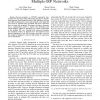Free Online Productivity Tools
i2Speak
i2Symbol
i2OCR
iTex2Img
iWeb2Print
iWeb2Shot
i2Type
iPdf2Split
iPdf2Merge
i2Bopomofo
i2Arabic
i2Style
i2Image
i2PDF
iLatex2Rtf
Sci2ools
GLOBECOM
2009
IEEE
2009
IEEE
P2P-ISP Cooperation: Risks and Mitigation in Multiple-ISP Networks
—Several proposals on P2P-ISP cooperation have recently been developed using information sharing for localitybased peering. Their benefits in terms of P2P efficiency, ISP cost, and traffic localization have been demonstrated in the single ISP case. However, potential risks associated with such cooperation have not been well examined. This paper develops a taxonomy and a mathematical model to explore the unintended and counter-intuitive behaviors emerging out of these cooperations in the multiple ISP case. Through both numerical examples and analytical results, we illustrate how such behaviors may become damaging to both P2P providers and ISPs, and how they might be mitigated so that the full benefit of cooperation can be maintained.
| Added | 20 May 2010 |
| Updated | 20 May 2010 |
| Type | Conference |
| Year | 2009 |
| Where | GLOBECOM |
| Authors | Aliye Özge Kaya, Mung Chiang, Wade Trappe |
Comments (0)

